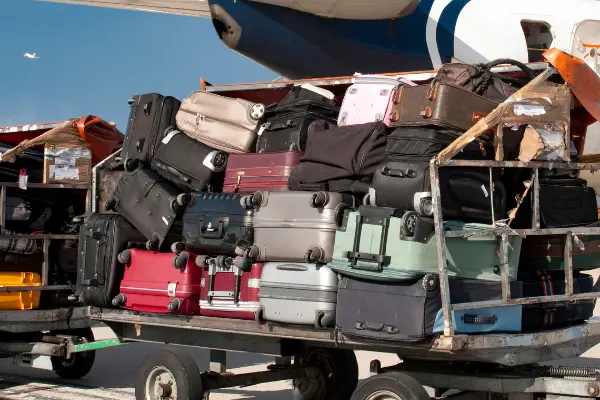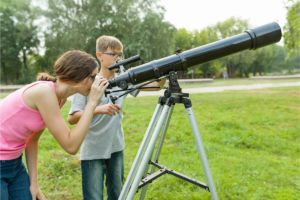How To Travel With A Telescope; Plane & Car
Disclosure: This post contains affiliate links and I may earn a small commission (at no extra cost to you) if you click through and make a purchase. Thanks in advance – I really appreciate it!
I still remember how anxious I was when I traveled for the first time with my telescope on a flight to Albuquerque. Although the telescope was safely tucked away between layers of foam in a bag in the carry-on compartment, I was still very worried about its safety.
If you have landed on this page then I am sure you too are wondering how and if you can carry a telescope on a plane.
Key Takeaways:
A telescope can be transported in a plane as a carry-on or checked-in baggage. If the telescope is small then use the carry-on method to avoid any damage. In the case of a larger telescope, transport optical tube and lenses separately as carry-on and the mount and tripod in checked-in baggage.
So, how do you safely transport your telescope so that nothing gets damaged along the way? Read on, to find out!
Related: Best Portable Telescope; Reviews
How To Travel With A Telescope On A Plane
Generally speaking, there are no specific rules against bringing telescopes on airplanes; the real question will be whether the bag or case that contains the telescope is small enough to qualify as carry-on luggage.
I highly recommend that you DO NOT TRANSPORT YOUR TELESCOPE IN CHECKED BAGGAGE.

Baggage handlers at the airports do not have the time or patience to handle each piece of luggage with the care that is required to handle a package containing something as delicate as a telescope.
They have to move hundreds of bags and suitcases in a day so don’t expect them to be careful with your checked-in telescope, even if you have stuck a “Fragile” sticker on it.
For the sake of practicality, a smaller portable telescope is ideal for air travel.
If the telescope is small and light enough, you can easily travel with it as a carry-on and store it in the overhead compartment.
Make sure that you cover the optical tube and eyepiece with their respective caps and stuff a few items of clothing in the same bag to provide your beloved telescope some cushioning.
Related: Best Small Telescope; Reviews
Be sure to check the carry-on luggage rules for the airline that you’ll be using, because qualifications for carry-on luggage can vary from one airline to the next.
If you still have the original packaging for your telescope, this would be one of the best choices for safely transporting your equipment.
Most of the time this packaging comes with customized styrofoam cutouts that perfectly conform to the shape of the telescope, offering a snug fit for the optical tube assembly and accessories.
You may also use a hard-side compact case to safely carry your telescope and accessories whenever you travel.
Related: Best Affordable Telescope; Reviews
In case you are planning to travel with a telescope that is too large to be transported as a carry-on, then it would be best to remove the optical tube from the mount and tripod.
You can keep the mount and tripod along with your clothes in the checked-in baggage. Wrap the sensitive areas with clothing to prevent bumps and scratches.
You can wrap the optical tube and lenses either in their original packaging or some foam, quilt, or clothes, (basically anything to give it a bit of cushion) and keep it in a bag and take it along with you as a carry-on.
Also consider the total weight of your carry-on bag, as weight restrictions will vary between airlines. Be sure to check the website of the airline you’ll be using to find out their policy regarding carry-on weight restrictions.
You can also check the policies on checked-in and carry-on baggage on TSA website.
Large eyepieces like Naglers show up as black objects on the X-ray machines, I guess the X-rays do not go through the heavy glass very well. Be prepared to have your bag hand-checked if you have such large eyepieces in your carry-on.
If you have a computerized telescope, you are sure to have batteries in the telescope.
As far as batteries go, keep in mind that wet cell batteries are not allowed on flights except for medical devices.
Another option when flying is to remember that 12V batteries are relatively cheap, so you may want to invest in a good charger to take with you, leave your big batteries at home, and purchase a new inexpensive battery after your flight lands. It can be figured into the cost of the trip, and you can charge it during the day.
Don’t forget to bring your collimation tools, because any kind of travel is going to require you to collimate your optics after you arrive.
In addition to collimation and adjustment tools, you’ll need to be prepared for more. Just because you’ve tested your setup before you left doesn’t mean you shouldn’t be prepared for something to break in transit or fail in the field.
Be sure to pack enough tools to be able to fix small problems should they arise, and all the right size Allen keys to tighten everything. And don’t forget your multi-tool, zip ties, and a roll of duct tape!
Related: Best Portable Telescope; Reviews
If you frequently travel with your telescope, I would definitely recommend something like a pelican case. This case will guarantee that your telescope meets you at your destination in exactly the same unbroken condition.
Use a lot of form-fitting foam inside and ensure there isn’t any movement inside. I’m not sure if fragile stickers work to make airline baggage employees take special care, but do it anyway.
How To Travel With A Telescope In A Car
It would be best to transport the telescope with the optical tube removed from the mount and tripod.
If you don’t have the original packaging, make sure to wrap the optical tube either in a quilt, bubble wrap, or expanded polystyrene packaging, and the mount as well.
Then make sure they are secure and won’t roll or slide around while you are driving.
Of course, one of the biggest concerns for most telescope owners is possibly cracking the mirror during transit.
You can set your mind at ease on this point because even thin telescope mirrors are incredibly tough.
You aren’t likely to damage the mirror unless you get in a collision, and then you’ll probably have bigger issues to worry about.
If your ride is bumpy you might knock out the collimation, but that should only take you a few minutes to correct at your destination.
Transporting a telescope for the first time can be a little nerve-wracking, but with the proper preparation, you’ll do just fine. Keep the above tips in mind to help you get your telescope where it needs to go without a hitch!
Written by:

Kavya Joshi
My love affair with space began in a field in India at the age of 7, when I looked up at the Milky Way for the first time. Ever since, I have been attempting to cram in every fact about the Universe, I can find into my head.
ABOUT US
We are a team of active amateur astronomers, here to help you with all your astronomy and science related needs – this is anything, from reviewing the latest telescopes to be released to talking about gravity and neurons. The Big Bang Optics was started because of our love for astronomy and to help others like us find the best telescope and accessories.
LEGAL DISCLAIMER
The Big Bang Optics is a participant in the Amazon Services LLC Associates Program, an affiliate advertising program designed to provide a means for sites to earn advertising fees by advertising and linking to Amazon.com. The Big Bang Optics also participates in affiliate programs with Clickbank and other sites. The Big Bang Optics is compensated for referring traffic and business to these companies.




